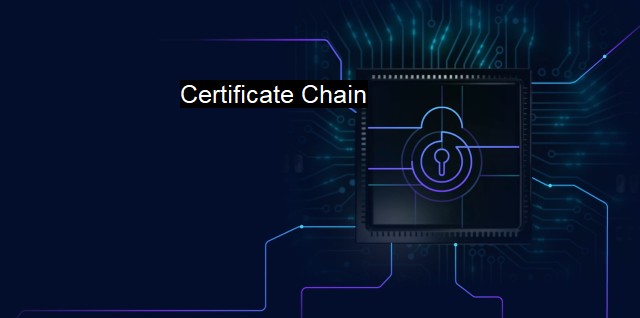What is Certificate Chain?
Understanding Certificate Chains: The Key to Secure Cybersecurity and Antivirus Infrastructure
A "certificate chain" is a string of certificates connected by a common thread of trust, and it's a fundamental component of modern internet security. This chain, also known as a certificate hierarchy, traces a path of trust from a trusted root certificate authority (CA) through intermediate authorities and finally to an end-user certificate. It forms the backbone of secure digital communication and is a vital aspect of cybersecurity.To comprehend the concept properly, an understanding of digital certificates is required. A digital certificate serves as an online passport that establishes credentials while doing activities on the web. It uses a cryptographic system to convert data into a virtually unbreakable code, then adds a digital signature that asserts the certificate holder's identity.
In its simplest form, a certificate chain consists of at least three levels. At the top is the root certificate, issued by a trusted third-party Certificate Authority. It verifies that the public key within belongs to the organization listed in the certificate.
Below the root are intermediate certificates. The intermediary CA's role is to serve as a link between the root and the end-entity certificate, while still maintaining some level of trust and authentication.
At the bottom is the end-entity or leaf certificate, the certificate for the website or application. This certificate is what an end-user interacts with; when the browser or application verifies this, it is indirectly verifying the entire chain leading up to it.
A fully functional certificate chain is imperative for browser trust. When a secured (HTTPS) connection is established, the server presents a certificate. The browser receives the certificate, then starts to verify. It checks the issuer of the certificate (intermediate) and the figure of the issuer's certificate (root). Trust is passed, or chained, up from the end-entity certificate through its connections.
Therefore examining the certificate chain's validity can be an essential task for detecting fraudulent or harmful websites and applications. Antivirus software often includes features for analyzing these chains, hence offering protection from potentially dangerous situations.
Missing or invalid certificates can raise red flags about the site or server's security or legitimacy, possibly revealing attempted phishing or man-in-the-middle attacks where a malicious entity impersonates a trusted site to saturate information from users. Checking the certificate chain helps to ensure the certificate is genuine and correctly installed, offering consistent encryption and trust throughout communication.
A certificate chain establishes a solid line of defense that is especially robust because it combines multiple layers of certification. Similarly to how a physical chain is only as strong as its weakest link, a certificate chain is only as secure as its least secure certificate. By ensuring an intact and trustworthy chain, vulnerabilities are minimized, and a secure line of communication is achieved.
The usage of certificate chains isn't without its pitfalls. With multiple parties involved in a chain, coordination can sometimes be tricky. The revoking of a certificate, perhaps due to unforeseen issues, will interrupt chains and might affect the entire hierarchy's validity.
In today's digital age where cyber attacks are frequently evolving, employing a valid certificate chain increases internet communication security and plays a pivotal role in preventing breaches. Through establishing chains of trust with reputable certificate authorities and comprehensively checking these tools, individuals and organizations can secure their operations and establish productive relationships based on mutual trust instead of susceptible to cyber threats.

Certificate Chain FAQs
What is a certificate chain?
A certificate chain is a series of digital certificates that are linked together to establish the authenticity and trustworthiness of a website or application. These certificates are used to verify the identity of a website or application and to ensure that it is secure and safe to use.Why is a certificate chain important?
A certificate chain is important because it helps to establish trust and security in online communication. By verifying the authenticity of a website or application, users can be confident that they are not being tricked into providing sensitive information to a malicious actor. Additionally, a certificate chain helps to prevent man-in-the-middle attacks, where an attacker intercepts communication and steals information.What happens if a certificate chain is broken?
If a certificate chain is broken, it means that the trust and security of a website or application have been compromised. This can happen if a certificate is expired, revoked, or issued by an untrusted authority. If this occurs, users may receive a warning message or be prevented from accessing the website or application altogether.How can I ensure that a certificate chain is secure?
To ensure that a certificate chain is secure, users should look for the green padlock icon in their browser's address bar. This indicates that a website has a valid SSL/TLS certificate and that the connection is encrypted. Additionally, users can verify the authenticity of a certificate by checking the issuer and expiration date. If in doubt, users should avoid entering sensitive information and contact the website or application owner for more information.| | A | | | B | | | C | | | D | | | E | | | F | | | G | | | H | | | I | | | J | | | K | | | L | | | M | |
| | N | | | O | | | P | | | Q | | | R | | | S | | | T | | | U | | | V | | | W | | | X | | | Y | | | Z | |
| | 1 | | | 2 | | | 3 | | | 4 | | | 7 | | | 8 | | |||||||